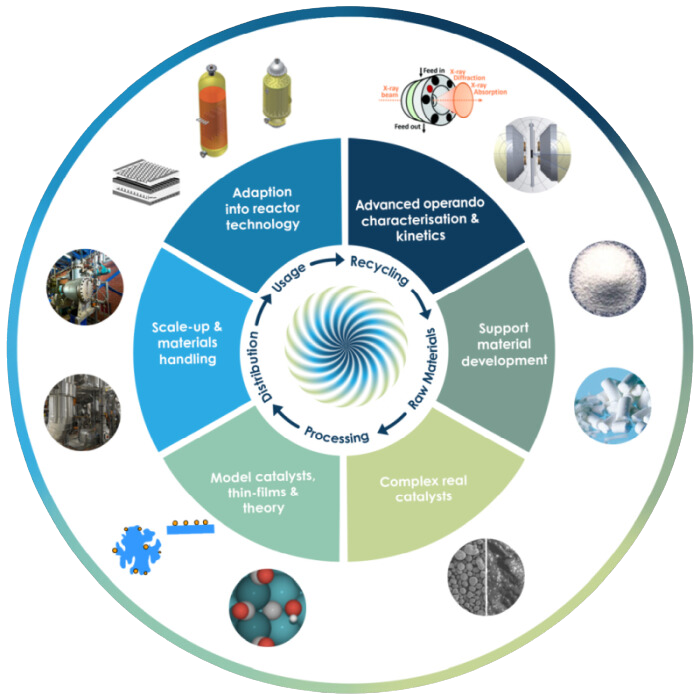CARE-O-SENE research cycle
Feel free to click on any topic in the picture for detailed information.

Life cycle analysis (LCA) and Technoeconomic Analysis (TEA)
The Life Cycle Assessment (LCA) estimates the environmental impacts of production of SAF from cradle to grave. This is done in work package 4. In this work package, Fischer-Tropsch product workup, regeneration and modelling are done to understand techno-economic aspects, while the relevant policy aspects of SAF are also studied.
Advanced operando characterisation & kinetics
The top image shows a schematic of the in-situ reactor cell that is used by KIT to conduct “operando” measurements at the synchrotron. Realistic pressures and temperatures can be used and information on the catalyst properties can be gathered for example with X-ray absorption (XAS) spectroscopy, while activity and selectivity data is collected at the same time. In a similar vein, in-situ magnetometry shown at the bottom used by UCT, can measure the magnetic and kinetic behaviour of catalysts under reaction conditions.
Support material development
These are various shapes of alumina support materials produced by Sasol Germany .
The top image is an example of a powder (micron-sized) version. These are typically applied as supports for cobalt slurry bed catalysts (Sasol) or for microstructured reactors (INERATEC).
The bottom image shows an example of an extruded (mm size) version. These are typically applied as supports for fixed bed catalysts.
Complex real catalysts
The image on the left hemisphere is a scanning electron microscope (SEM) image of industrial alumina support, which is pre-shaped prior to catalyst preparation. The support must have the right properties (shape, size distribution, strength etc.) for use in the Fischer-Tropsch reactor.
The image on the right hemisphere is a transmission electron microscope (TEM) image showing cobalt on alumina catalyst. The image is taken in dark field mode, where cobalt appears as white and the alumina support grey.
Model catalysts, thin-films & theory
The image on the left shows industrial catalysts (Sasol) which are complex with metal particles (orange) hidden inside the pores. This makes them difficult to characterize. Flat models or thin films can be made (blue bar on the right), where the metal particles are assessable to surface characterisation techniques (HZB).
The round picture on the far right shows CARE-O-SENE’s density functional theory (DFT) or molecular modelling done at UCT, and KIT . We make models of the cobalt surface and use theory to understand how the molecule, in this case CO (grey and white) interacts with the cobalt surface (blue).
Scale-up & materials handling
The top image shows a pilot plant vacuum drier (Loedige-type). It is used to impregnate cobalt onto the support in a water medium and employs vacuum drying to evaporate the liquids leaving a dried cobalt-containing material. On pilot scale around 10-30kg material is normally prepared.
The image on the bottom shows a section of a Fischer-Tropsch catalyst plant, which demonstrates the envisaged, eventual scale up of a potential catalyst. A fluidised bed catalyst preparation reactor can be seen in the foreground.
Adaption into reactor technology
The illustration on the left shows the stacking of the microstructured reactor, showing the pillar structured catalyst foils and the cross-flow rectangular oil channels INERATEC ).
The image in the middle shows a slurry reactor used by Sasol in GTL plants but also potentially in small scale (2500bbl/day) PtL-plants.
The image on the right is an illustration of fixed bed reactors; these use extruded or shaped catalysts. This reactor shown is an ARGE-type reactor that was used by Sasol in Sasolburg. IKTS/MAN will test the fixed-bed concept.